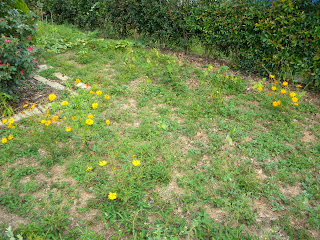 I like surprises, giving more than getting, but there was one waiting for me at the beginnning of the week. Monday found us still at home for a long weekend--thanks to SAM's understanding boss--and I was up with the sunrise, walking through the wet grass and taking in the sights and sounds of an early morning. I guess the dew slowed me in my flip-flops enough so I could spot these Green Darners, Anax junius, dangling from a palm frond. They were oblivious to me while in the midst of an extended embrace so I took the opportunity to snap away...
I like surprises, giving more than getting, but there was one waiting for me at the beginnning of the week. Monday found us still at home for a long weekend--thanks to SAM's understanding boss--and I was up with the sunrise, walking through the wet grass and taking in the sights and sounds of an early morning. I guess the dew slowed me in my flip-flops enough so I could spot these Green Darners, Anax junius, dangling from a palm frond. They were oblivious to me while in the midst of an extended embrace so I took the opportunity to snap away...I approached them from different angles, curious about which one was male and female and what they were called, besides dragonflies, of course. That bug collection assignment in the fifth grade wasn't a total waste of time. Yes, Mrs. Whatever-Your-Name-Was--thank you very much--these are dimorphic insects, meaning that the two sexes look different from each other. That's helpful. The male in this case is the one in the upright position with the blue abdomen. He has the end of it inserted behind the female's head. This dragonflies-for-dummies article describes the insects' life cycle and has some excellent photos but doesn't include a lot of details like why the dragonflies resort to such an odd method of making babies! You should check out this National Geographic article if you're not satisfied with the basics. Dragonflies have such complicated mating rituals that scientists are still scratching their heads over what it all means. This isn't exactly an embrace. The male has the female's head pinned with special claspers on his tail so he can get down to business and also so she can't bite his head off. Of course, evolution provides the explanation for this strange, "ersatz heart" position. Doesn't it always? The dragonflies and damselflies apparently have this courting and mating thing down pat. The article says their time on earth--more than 300 million years--gives them an edge over other creatures, considering their diversity and distribution, and that they have had plenty of "time to figure all the angles on sex." Good for them! I'm glad I'm not an insect.
Since I'm human, I get to enjoy things--like brilliant colors and stained-glass patterns on sunlit wings.
 We surprised Daughter the day before the dragonfly sighting with a homemade cake--white chocolate with cherry topping--some flowers, balloons, and a card with two poems inside. Here is one of them, full of clues about what else she can expect:
We surprised Daughter the day before the dragonfly sighting with a homemade cake--white chocolate with cherry topping--some flowers, balloons, and a card with two poems inside. Here is one of them, full of clues about what else she can expect: Look under the rug
Peek under the bed
Where is the darn thing
The birthday girl said
I don’t want a present
But it must be here somewhere
Is it something round?
Or will it be square?
If it’s stashed somewhere small
A piece may be pok’n
But if it’s too tall, it may be brok’n
The parents look sly
And say, Daughter… Truly Spok’n
Happy Birthday,
Dad
Can you guess what her surprise was?
She picked it out, and we brought it home the next day, a few hours after the sun rose and the Green Darners flew away.














